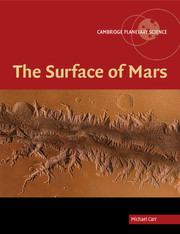4 - Global structure and tectonics
Published online by Cambridge University Press: 12 August 2009
Summary
Recent work on martian meteorites and recent acquisition of high-resolution global topography and gravity enables more constrained models to be made of Mars' internal structure and evolution than was formerly possible. The isotopic data from meteorites demonstrates unambiguously that Mars formed and differentiated into core, mantle, and crust in a remarkably short period of time, just a few tens of millions of years after the formation of the Solar System. The recent discovery of large magnetic anomalies in old terrains suggests also that for the first 0.7 Gyr the core was convecting and producing a strong magnetic field. In addition, the global dichotomy and Tharsis both appear to have formed during the same period. Thus, the first 0.7 Gyr of the planet's history, through the pre-Noachian until roughly the end of the Noachian, was one of rapid change.
The first part of this chapter concerns these early events. The evidence for the timing of global differentiation is summarized, and the global dichotomy is described, as is evidence for the early formation of Tharsis. The global north–south dichotomy is expressed in three ways: as a difference in elevation (high in the south, low in the north), as a difference in crustal thickness (thick in the south, thin in the north), and as a change in crater density (high in the south, low in the north). Its cause remains controversial.
- Type
- Chapter
- Information
- The Surface of Mars , pp. 77 - 94Publisher: Cambridge University PressPrint publication year: 2007
- 1
- Cited by

